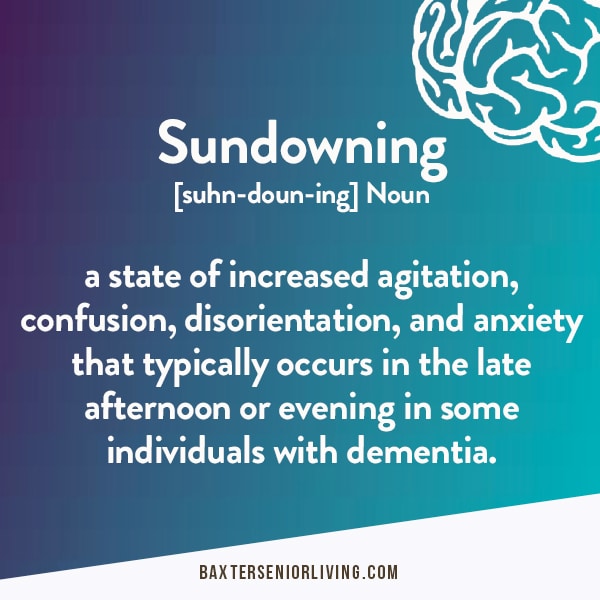Sundown syndrome (or sundowning) is a sleep disorder and one of many grouped symptoms that are collectively referred to as dementia. One of the most common forms of dementia is a progressive disease known as Alzheimer’s, which is characterized by the destruction of neurological functions, including memory.
This disorder affects about 20% of those with Alzheimer’s and the term “sundowning” is derived from the time of day of the symptom onset.
As the sun starts to go down and natural light fades away, a person with dementia will often start to feel increasingly worse the later it gets. This can begin as early as the late afternoon, depending on the season, since fading daylight appears to be the main trigger.
It’s thought that in some people with dementia, the parts of the brain that control circadian (or biological) rhythms have become disrupted.
What Are The Triggers Of Sundowning?
An individual with dementia may become more susceptible to sundowning when they are tired out from a challenging day. This can cause them to have difficulty in separating reality from the content of their dreams. Additionally, the low-light levels of the evening can produce a lot of shadows within their environment, and these may be perceived as visual hallucinations.
A urinary tract infection (UTI) or another infection may also increase the likelihood of a sundowning episode taking place.
Confusion is the predominant manifestation of this disorder, but the sufferer can also become angry and/or anxious. The frustration of this change in mood can provoke a sufferer into wandering behavior. Other symptoms may include:
- Paranoia
- Hallucinations
- Mood Swings
- Restlessness
- Irritability
- Agitation
- Disorientation
How Can You Avoid Late-Day Confusion?
To avoid the chance of sundown syndrome occurring in older adults with dementia, having these individuals adhere to regular routines may help. This applies to the activities of daily living and ensuring that they occur on a reliable schedule.
Exercise is also helpful, provided that vigorous physical activity does not take place too late in the day, causing over-stimulation.
If an elderly individual with sundown syndrome isn’t getting enough natural light during the day, consider using a light therapy box or obtaining full-spectrum fluorescent bulbs. When sundown approaches, close the curtains before shadows form. Those with dementia benefit from more lighting at night, so have plenty of lamps and automatic nightlights, which can also help to prevent falls.
Coffee, alcohol, nicotine, and sugar are best avoided in the afternoon and evening. Try to leave a 6-8 hour caffeine-free gap before bedtime so that the onset of tiredness and sleep is not disrupted.
Daytime napping is also best avoided, especially in the late afternoon and evening. If this seems impossible to prevent, try to limit the duration of late-day sleep as much as possible.
To prepare for sleep, start quietening the living space early in the evening. Aim for a calming environment and routine activities that will relax the mind. If a senior enjoys watching TV, try to steer them away from programs or themes that may agitate them.
It’s best to make a conscious effort not to bring up any stressful topics of conversation in the evening.
For seniors who are in a new environment, try to familiarize them with their surroundings. Place personal items on display, such as family photographs and other objects that they respond to positively.
What Can You Do If Sundowners Persists?
A doctor may be able to help with persistent sundowners, and a root cause or several triggers may be identified.
The risks and benefits of sleep medication should be carefully assessed on an individual basis. The side effects and possible interactions may be deemed too severe, especially if a serious health condition already exists that may be adversely affected. Those over 65 years of age have an elevated chance of falling, and sedatives can compound this risk.
Melatonin therapy has been shown to decrease sundowning in some studies of dementia patients. Melatonin is the hormone that regulates the sleep-wake cycle, and secreted levels commonly decrease in those with Alzheimer’s disease.
Installing a motion sensor or similar device can help alert a caregiver to the wandering behavior linked with sundowning. When you do encounter an elderly person who is exhibiting behavior that is consistent with sundown syndrome, be patient and stay calm. Point out the time without being confrontational in your approach, and do all you can to ensure their safety and well-being.

